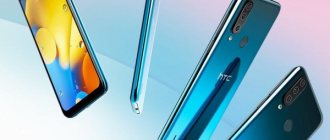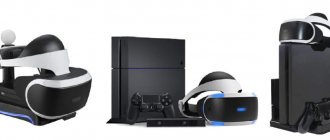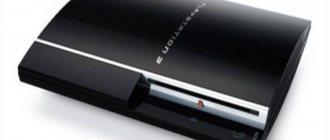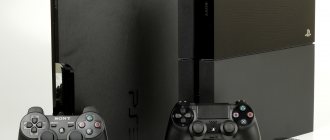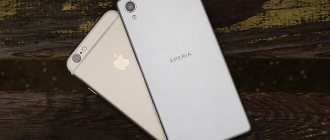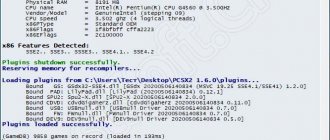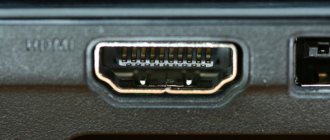Console versions and configurations
All PSP consoles are exactly the same functionally. They differ only in the color of the body. However, on sale you can find several different versions of the console configuration, differing in price and the set of accessories included with the PSP.
At the start of PSP sales in Japan, Sony introduced two versions of the PlayStation Portable console. These basic configurations with minor variations later appeared on sale in other regions:
PlayStation Portable Core Pack
The cheapest version of the Sony PSP package.
Later, Sony introduced two more versions of the console configuration:
PlayStation Portable Entertainment Pack
This version of the Sony PSP package replaces the Value Pack in some regions.
Equipment
|
PlayStation Portable Giga Pack
Finally, in the fall of 2005, the Giga Pack version went on sale in all regions. Note that since the beginning of 2006, this version has disappeared from sale in North America.
Equipment
|
Thus, the Giga Pack version is the most expensive and richest retail package of Sony PSP at the moment.
Please note that other versions of the console configuration may be available for sale in certain regions, but the consoles themselves are absolutely identical in functionality everywhere.
Optional equipment
Simultaneously with the start of sales of PlayStation Portable consoles, Sony introduced a number of accessories sold separately from the two main configurations.
Sony accessories sold separately from the consoles themselves can be divided into:
- accessories supplied with the consoles themselves;
- accessories offered separately from all retail versions of the console configuration.
In the following lists, accessories included in any package are indicated in italics
.
Interface
| PlayStation Portable Headphones with Remote Control The remote control allows you to control the playback of audio files. |
| PlayStation Portable Headset Headphones with microphone for PSP. Used for voice communication in some games. |
| PlayStation Portable Go! Camera Video camera for PSP with a resolution of 1.3 MP. Allows you to take photos, record videos (equipped with a microphone) and saves them on Memory Stick. |
Nutrition
| PlayStation Portable Battery Pack Battery for PSP. |
| PlayStation Portable Extended Life Battery Increased capacity battery for PSP (up to +20% increase in console battery life). |
| PlayStation Portable AC Adapter Charger for PSP. |
| PlayStation Portable Car Adapter Car charger for PSP. |
| PlayStation Portable Battery Charger PSP battery charger. Allows you to charge the battery outside of the console. |
Bags and cases
| PlayStation Portable System Pouch & Wrist Strap Case and Strap for PSP. |
| PlayStation Portable Accessories Pouch & Cleaning Cloth |
| PlayStation Portable Carrying Case A bag for carrying PSP, accessories and UMD discs. |
Other
| PlayStation Portable GPS Attachment GPS receiver for PSP. |
1 - Currently only sold in Japan.
Sony PSP-3008 Black Base Portable Game Console - Specifications
Your PSP world just got better and brighter with the new PSP-3000 series. Putting your entire world in your hands, comes a new model of the massively popular PSP that brings together all the fantastic features and looks of the PSP Slim & Lite, plus two exciting new features. The PSP-3000's built-in microphone means you can say goodbye to wires and headphones and chat with friends online via Go!Messenger and Skype, all you need is a wireless Internet connection.
Connect with friends and family via Go!Messenger. Chat with friends using the built-in microphone or connect your PSP camera for one-on-one video chats.
Stay connected wherever you are with Skype on PSP. Chat by video or voice with anyone on Skype and save money on your calling costs by subscribing to one of Skype's Unlimited plans or purchasing Skype Credit.
Not only can you stay connected to the world, but your PSP world will look even better. The PSP-3000's screen displays a wider range of colors for even greater picture clarity. And thanks to anti-glare technologies, you'll be able to use your PSP comfortably in sunlight and harsh indoor lighting.
Differences from PSP-2000: 1) The Sony logo is now under the L - trigger. 2) The Home button has now been replaced with a -PS- icon. 3) The lid ring on the UMD is now thinner than on the PSP-2000. 4) The PSP-3000 will be more comfortable to hold than its predecessors. 5) Built-in microphone. 6) Improved display - The color gamut is doubled, the response time is half as fast, and the contrast is five times higher. 7) The -Color Space- option will appear in the system settings, thanks to which the user of the new console will have the opportunity to switch between two color modes - Wide - in which the PSP 3000 will show the maximum possible color depth, and Normal - in this mode the color will be the same as PSP-2000. Automatic USB Connection option - when this option is enabled, the USB connection will be activated automatically. 9) Noise suppression when connecting the console to a TV. 10) John Koller stated that the PSP 3000 will live 20-30 minutes less, but recently reassured us with the message that the PSP 3000 battery life will be equivalent to the previous console model, that is, there is nothing to be afraid of, and we, as before, will be able to spend from 4 to 6 hours playing games, and all thanks to the fact that the company's engineers managed to reduce the power consumption of other parts of the PSP.
2) The Home button has now been replaced with a -PS- icon. 3) The lid ring on the UMD is now thinner than on the PSP-2000. 4) The PSP-3000 will be more comfortable to hold than its predecessors. 5) Built-in microphone. 6) Improved display - The color gamut is doubled, the response time is half as fast, and the contrast is five times higher. 7) The -Color Space- option will appear in the system settings, thanks to which the user of the new console will have the opportunity to switch between two color modes - Wide - in which the PSP 3000 will show the maximum possible color depth, and Normal - in this mode the color will be the same as PSP-2000. Automatic USB Connection option - when this option is enabled, the USB connection will be activated automatically. 9) Noise suppression when connecting the console to a TV. 10) John Koller stated that the PSP 3000 will live 20-30 minutes less, but recently reassured us with the message that the PSP 3000 battery life will be equivalent to the previous console model, that is, there is nothing to be afraid of, and we, as before, will be able to spend from 4 to 6 hours playing games, and all thanks to the fact that the company's engineers managed to reduce the power consumption of other parts of the PSP.
Specifications
CPU
The CPU was developed by Sony specifically for the PlayStation Portable and is a highly integrated chip that, in addition to the central processor, contains an additional core for decoding multimedia content.
| Architecture |
|
| Caches |
|
| Frequency |
|
| Complexity |
|
| Technical process |
|
| External bus |
|
Video system
The GPU Graphics Engine was developed by Sony specifically for the PlayStation Portable and contains 2 MB of internal memory for creating a frame buffer.
| Conveyors |
|
| eDRAM |
|
| Technical process |
|
| Frequency |
|
| External bus |
|
System memory
| Architecture |
|
| Volume |
|
| Frequency |
|
| PS memory bus |
|
Audio system
| Characteristics |
|
| Conclusion |
|
Information carriers
| UMD |
|
| Memory cards |
|
Interface and communication devices
Console screen
| Type |
|
| Size |
|
| Permission |
|
| Chroma |
|
Input Devices
| Game management |
|
| Other keys |
|
| Other |
|
Networking capabilities
| WLAN |
|
Ports and connectors
| USB |
|
| Infrared port |
|
| Memory card slots |
|
| Power connector |
|
| Headphone jack |
|
physical characteristics
| Weight |
|
| Dimensions |
|
| Colors |
|
1 - unofficial information.
Sony PlayStation Portable
Short description:
- Processor: MIPS R4000 (333 MHz)
- Screen: 4.3 inches diagonal, resolution 480×272 pixels, brightness 200 cd/m2
- Optical drive: UMD (Universal Media Disc)
- Wi-Fi module (both for surfing the Internet and for playing together)
- Memory cards: Memory Stick Duo
- IR port
- Built-in stereo speakers
- USB 2.0 (miniUSB connector)
Appearance
Today, the device is available in a wide variety of colors. The set-top box may confuse an inexperienced user with the abundance of all kinds of buttons and connectors. In fact, everything is not so scary - all this diversity is very easy to understand. The ergonomics of the device are excellent. It fits well in the hands and there are no problems during gameplay. Of particular note is the presence of an analog joystick on the console, which is very unusual for a portable device.
Accessories
It should be remembered that the PSP is not just a game console, but, in fact, a real pocket computer. And therefore her accessories are appropriate. For example, if necessary, you can purchase add-ons such as a web camera or GPS module. On sale you can find external keyboards, mice, and special docking stations that turn the PSP into a portable music center. The console itself can be connected not only to a computer, but also to its “big sister” - Sony PlayStation 3.
Console Features
PSP can be used for more than just games. It can also serve as a compact media player (the sound quality is excellent), an organizer, a GPS navigator (if you purchase an additional GPS module) and a photo album. A huge amount of a wide variety of software has been written for the console, which can significantly expand its capabilities. It is also possible to update the firmware.
The set-top box is capable of working with UMD format disks with a capacity of 1.8 GB. It should be remembered that films recorded in the USA on the European version of the set-top box will not work (divided into zones, as in regular DVD players). This does not apply to game discs.
Accumulator battery
The battery life of the PSP depends largely on the game you are playing and can range from 3 to 5 hours. You have no more than 5 hours when watching movies. Well, if you use the set-top box only to listen to music, then the operating time increases to 7-8 hours. If the set-top box is used very actively, then it makes sense to immediately buy an additional battery.
Graphic arts
Despite its compact size, the PSP provides a high level of graphics. The console is equipped with a fairly large widescreen screen with an aspect ratio of 16:9. When operating from an adapter, the brightness level is 200 cd/m2, when operating from a battery - 180 cd/m2. Unfortunately, the screen fades a lot in the sun.
Equipment:
- The console itself
- Memory card (quantity and capacity may vary depending on the package included)
- Battery charging adapter (100V - 240V, 50/60 Hz)
- Headphones with volume control
- Soft case
- Accumulator battery
- Instructions, warranty card, demo disc
- Screen wipe
- Hand strap
- USB cable (also not included in all packages)
Key dates
Announcement dates and other dates
| 11.03.2004 | Official announcement of the console, E3, Los Angeles, USA |
| 01.09.2005 | Release of firmware version 2.00 (adding a full-featured web browser) |
| 21.11.2006 | Release of firmware version 3.00 (adding PlayStation console emulator) |
| 04.04.2007 | First official console price cut (in North America) |
Sales start dates
| 12.12.2004 | Japan |
| 24.03.2005 | USA and Canada |
| 02.05.2005 | South Korea |
| 01.09.2005 | European Union and Australia |
| 09.09.2005 | Russia |
⇡#Foresight
Sony PSP was announced in 2003 at E3, but details about its device became known only a year later, in May 2004. It’s very difficult to admire the technical characteristics in hindsight, but I remember well that then, seven years ago, the PSP was simply taken aback by some parameters. First of all, I was amazed by the 4.3-inch screen with a resolution of 480x272 pixels, displaying 16 million colors. Just for comparison, the newly released Nokia 6600 smartphone had a screen resolution of 176x208 pixels, while the dream of all gadget lovers, the Sony Ericsson P900, had a screen resolution of 208x320. And, of course, no millions of shades: the industry had only just begun to massively switch to 16-bit matrices with their 65,536 colors. And the PSP screen was not only very clear and amazed with rich colors, but also did not “slow down” in dynamic game scenes. Again, it should be recalled that back in 2004, LCD monitors had not yet replaced CRTs, and one of the reasons for this, along with the rather high price, was too long a response time. That is, working in Word and flipping through pictures is fine, but playing and watching movies was no longer possible.
Next - processors. That's right, in the plural, because there are two of them in the PSP. The first, with a long and not very “marketing” name CXD2962GG, is responsible for various types of calculations and contains a coprocessor for floating point operations. It was made using 90-nanometer technology, like the most modern processors from Intel and AMD at that time. I clarify this for good reason: in modern gadgets that use alternative architectures, the CPU process technology lags behind the x86 platform by a step, or even two. At first, the speed of processors in the PSP was limited to 266 megahertz (apparently, that was enough), but then, with the next firmware update, it grew to 333. Can you imagine something like that in a modern smartphone?
The CXD2962GG also has an integrated graphics core operating at frequencies up to 166 MHz. Just don’t rush to laugh - for 2004 this was quite decent. Suffice it to remember that the chip of the fastest graphics accelerator for PC at that time, ATI Radeon 9800 XT, operated at a frequency of 412 MHz, but here is such a small thing, and only a little more than two times less. The PSP graphics core communicates with the main memory via a 256-bit bus, pumping up to 5.3 GB/s, and the internal memory capacity is 2 MB. The baby supports hardware texture compression and tessellation, processes up to 33 million polygons per second, and its fillrate reaches 664 megapixels per second. Compared to video cards of the latest generations, these are, of course, tears. But don’t forget that we are talking about a seven-year-old mobile product with a screen resolution five times less than that of the simplest netbook. At first, the graphics quality in PSP games was simply amazing. Now, of course, it doesn’t cause much excitement, because the capabilities of the “big” accelerators have stepped far forward, but to this day most games look quite decent. But here, of course, we should thank not only the developers of the PSP hardware, but also the harsh censors of Sony, who did not allow outright hack work on the platform.
Despite the year of birth written on the surface of the processors, they still feel quite confident
Another processor, CXD1876, is responsible for processing media data in the PSP. In terms of characteristics, it is almost no different from the CXD2962GG, but instead of a graphics core, it contains a programmable DSP and a hardware MPEG-4 decoder. The platform is able to divide computational threads between two CPUs, and it turns out that back in 2004, a small game console was already dual-core. The Pentium 4 will learn this trick only in 2005, and the prevalence of software that effectively uses multi-core systems on the x86 platform leaves much to be desired to this day.
From the very beginning, the Sony PSP had another completely exotic feature at that time - WiFi support. In the first firmware it clearly did not show itself, and many sincerely believed that the PSP's wireless capabilities were limited to the infrared port. However, WiFi soon appeared in one of the games, and then its presence was no longer made a secret, and in the second version of the firmware they even added a good Internet browser.
Seven years ago there was no iPad with its ten hours of battery life, so six hours without recharging in game mode and watching videos looked very cool. Can your iPhone or Android smartphone last that long in something 3D? To be honest, I'm not sure. Moreover, if in the first version of the PSP (PSP-1000) a battery with a capacity of 1800 mAh was required to achieve such indicators, then three years later the design of the console was optimized, and 1200 mAh was enough for it. An example worthy of emulation.
Games for the PSP were planned to be sold on optical discs in the proprietary UMD format, and Memory Stick Duo cards were proposed to be used to store data generated during the operation of the console. Sony also began releasing films on UMD, which, however, did not gain much popularity. But this appears to have been one of only two PSP-related failures.
Starting game lines
Starting lineups are provided for three main regions: North America, Europe and Japan. Italic
exclusive PlayStation Portable projects are noted.
Please note that the official launch lineup of games for the European Union has not been announced, and the list we provide may not be complete.
| Name of the game | S. America | Europe | Japan |
| Ape Academy | – | • | – |
| Ape Escape: On the Loose | • | – | – |
| Archer Maclean's Mercury | – | • | – |
| Armored Core Formula Front | – | – | • |
| Colin McRae Rally 2005 | – | • | – |
| Darkstalkers Chronicle: The Chaos Tower | • | • | • |
| Dynasty Warriors | • | • | – |
| Everybody's Golf | – | – | • |
| Fired Up | – | • | – |
| Gretzky NHL | • | – | – |
| Lumines | • | • | – |
| Mahjong Taikai | – | – | • |
| Metal Gear Acid | • | • | – |
| Midnight Club 3: DUB Edition | – | • | – |
| NBA | • | – | – |
| Need for Speed Underground: Rivals | • | • | – |
| NFL Street 2: Unleashed | • | – | – |
| Ridge Racer | • | • | • |
| Smart Bomb | – | • | – |
| Spider-Man 2 | • | • | – |
| Tiger Woods PGA Tour | • | – | – |
| TOCA Race Driver 2 | – | • | – |
| Tony Hawk's Underground 2 Remix | • | • | – |
| Twisted Metal: Head On | • | – | – |
| Untold Legends: Brotherhood of the Blade | • | • | – |
| Virtua Tennis World Tour | – | • | – |
| Wipeout Pure | • | • | – |
| World Snooker Championship 2005 | – | • | – |
| World Tour Soccer | • | • | – |
The most successful platform games
The most successful projects for the PlayStation Portable are given according to the website www.gamerankings.com as of the beginning of April 2007 (only games with the number of reviews equal to or exceeding 5 are taken into account).
Overall ten most successful projects
Exclusives are marked in italics
.
| Name of the game | date of release | Average rating |
| Lumines | 12.12.2004 | 90,2% |
| Wipeout Pure | 24.03.2005 | 88,7% |
| Ridge Racer | 12.12.2004 | 88,5% |
| Tekken: Dark Resurrection | 06.07.2006 | 88,5% |
| Puzzle Quest: Challenge of the Warlords | 16.03.2007 | 87,5% |
| Grand Theft Auto: Liberty City Stories | 25.10.2005 | 87,4% |
| Siphon Filter: Dark Mirror | 14.03.2006 | 87,2% |
| Daxter | 14.03.2006 | 86,8% |
| Burnout Legends | 13.09.2005 | 86,8% |
| Metal Gear Solid: Portable Ops | 05.12.2006 | 86,8% |
Ten of the most successful exclusives
| Name of the game | date of release | Average rating |
| Lumines | 12.12.2004 | 90,2% |
| Wipeout Pure | 24.03.2005 | 88,7% |
| Ridge Racer | 12.12.2004 | 88,5% |
| Siphon Filter: Dark Mirror | 14.03.2006 | 87,2% |
| Daxter | 14.03.2006 | 86,8% |
| Burnout Legends | 13.09.2005 | 86,8% |
| Metal Gear Solid: Portable Ops | 05.12.2006 | 86,8% |
| Ratchet & Clank: Size Matters | 13.02.2007 | 86,8% |
| Virtua Tennis: World Tour | 01.09.2005 | 85,9% |
| LocoRoco | 23.06.2006 | 85,2% |
Games and multimedia.
After removing the UMD socket, all multimedia applications and games should be accessible from the 16 GB of internal memory or Micro M2 flash card. Users can download software from the PlayStation Store directly to the PSP Go (via Wi-Fi) or by transferring data from a PC or PS3 via USB. Sony will be selling big budget downloadable games (which will also be available on UMD) and for this type of game I recommend downloading the games to your PC or PS3 and then dumping them onto your PSP Go instead of using the Wi-Fi connection on your PSP. For example, downloading Motorstorm: Arctic Edge (520MB) via Go takes over 2 hours. While on PC the download took less than 20 minutes. PlayStation Store is not the most convenient online app store service that I have used. You won't be able to see screenshots from games, and for the most part they are not sorted in the most convenient or logical way. Plus, once you start downloading the game, your PSP Go essentially becomes locked, i.e. you cannot use it for any other purpose until your download is complete. If you have content on several Sony devices and you are going to synchronize it with the PlayStation Network online service in order to be able to play everything you downloaded or purchased on all devices (games, videos). This is not the most convenient way, but it works, and the fact that you can sync up to 5 Sony devices (PSP and PS3) is really exciting. The best example of this is games originally developed for the Psone, which can be played on both the PS3 and PSP. Once you purchase them, you can synchronize them with other PSP or PS3 devices by downloading the game to your account at no additional cost. For PSP owners upgrading to Go, you'll have to manually move your saved files from the Stick Pro Duo to your new system. This is, of course, inconvenient. But if you want to continue a game that has been synchronized with the online service, you should do so. Also, the lack of a UMD drive prevents you from playing your old UMD games. This is yet another reason for current PSP owners to think twice before upgrading. Besides gaming, the PSP Go is also a solid multimedia device. In addition to playing videos, digital music and viewing photos, there is also a built-in web browser. In addition, a special Internet radio player has appeared (although setting up access to the Internet and music is something more confusing than it should be). Cables to connect your PSP Go to your TV (for watching videos and playing games) must be purchased separately.
Recommended prices
The dynamics of changes in the recommended retail price are monitored for four regions: North America, Europe, Japan and Russia.
We are monitoring price trends for the Core Pack and Value Pack configurations, but we would like to note that the start dates for these configurations may differ in some regions, and in some regions other configurations are sold at the Value Pack price.
| date | S. America | Europe | Japan | Russia |
| 12.12.2004 | — | — | 19'800 / 24'800 JPY | — |
| 24.03.2005 | n/a / 249.99 USD | |||
| 01.09.2005 | n/a / 249.99 EUR | |||
| 09.09.2005 | n/a / 8'499 RUR | |||
| 14.03.2006 | 199.99 / 249.99 USD | |||
| 22.03.2006 | 199.99 / 249.99 EUR | |||
| 03.04.2007 | $169.99 / $219.99 | |||
| 04.05.2007 | 169.99 / 219.99 EUR |
Platform sales dynamics
The dynamics of platform sales volumes are monitored for three main regions: North America, Europe and Japan.
The data for this section uses official reports of the number of consoles delivered to certain markets.
| date | S. America | Europe | Japan | Total |
| Start of sales | 0 | 0 | 0 | 0 |
| 21.10.2005 | 4.5 million | 2.5 million | 3 million | 10 million |
| 31.01.2007 | 10 million | 9 million | 5 million | 24 million |
Danil Gridasov ( [email protected] ) Published - April 9, 2007 Updated - May 11, 2007
